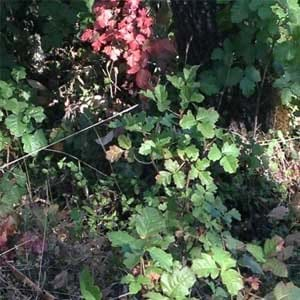Are you still looking for answers about poison ivy and oak that we have not covered in our website content? This page includes recently asked questions by consumers like you. Another great resource is our Tips & Info page.
If you do not see your question in the list below, you can try searching in the top search bar or contact us. We will get back to you as soon as possible.
See previous questions and answers below:
Yes. Even when the plants are dead, the resin that causes the rash remains active. Removing the plants entirely is the best way to avoid contact with them.
No. The poison oil remains toxic and does not evaporate. All parts of the living or dead poison plants, including the roots, flowers, or berries, contain the urushiol oil. Be especially careful of dead vines on firewood and leafless vines in the winter.
Yes, in the sense that poison oak can grow in different forms such as a vine, shrub, or ground cover. For more help with plant identification, see our plant images.
Yes, be careful, because you can get the rash from your pets. Since the animals' fur protects their skin from the oil, they won't get the rash. However, the oil will remain on their fur and will contaminate you when you touch them. You can use Tecnu to bathe animals. Apply Tecnu to dry fur, rub in, and fully rinse.
Most likely, no. However, if any of the leaves have fallen onto the deck/chairs in previous seasons, the oil may be on those items, leading to secondary contamination. That would be the most likely cause for a person to develop a rash in this case. If so, you may consider wiping down the furniture with Tecnu (after spot checking first for colorfastness). It is our understanding that burning the plant is the only way the oils can be airborne.
Yes. If the plant is burned in an open fire, it is possible to get poison oak or ivy systemically by breathing the smoke of burning poison oak or ivy. If you think you have poison oak/ivy systemically, see your doctor; this can be a fatal condition. In some states it is illegal to burn poison oak/ivy. NEVER BURN IT!
While poison ivy typically grows in leaf clusters of 3, on occasion, leaves can grow in clusters of 5 or 7.
Yes, poison ivy will bloom tiny white flowers before they turn into berries. The berries range from grayish to white in color. See our pictures of poison ivy plants for a more detailed description, and to see what poison ivy looks like.
No poison oak stems do not have thorns on them. Poison oak grows as a shrub or a climbing vine.

You are looking for a poison ivy barrier product, which we do not currently make. If you have been (or, think you may have been) exposed to poison oak or poison ivy plants, washing with a cleanser designed to remove urushiol (rash-causing oil from the plants) within 8 hours after exposure can help remove the resin before a rash begins. Such cleansers include Tecnu Original and Tecnu Extreme.
Bleach may appear to be a quick fix to poison oak or ivy. However, bleach removes the top layer(s) of your skin. Using it can irritate your skin and in the process weaken it so that the rash may become worse. Your skin may then become more susceptible to getting the rash in the future.
In a sense, yes. poison ivy (or, oak) rash will heal on its own. Poison ivy rash cannot be "cured", but you can treat the symptoms of a rash (redness, itching, swelling, blisters) with over-the-counter (OTC) treatments. However, for a rash lasting 10-14 days or longer with little to no improvement using OTC's, we recommend contacting your physician.
Yes, blistering and oozing are common reactions to poison oak and ivy rash during the healing process.
If the urushiol (rash-causing oil) has not yet absorbed fully into your skin, and you are not using a cleanser to remove urushiol from the skin's surface, it is possible to spread the oil to other areas of the body. After contact with poison oak or ivy plants, it is best to wash as soon as possible with a cleanser designed to remove urushiol such as Tecnu Original or Tecnu Extreme.
You can either pull the plants out of the ground, or head to your local home and garden center where a store employee can recommend the best weedkiller to eradicate poison oak and ivy plants. If you choose to pull the plants out yourself, there are a few tips we recommend following:
1.) Wear long sleeves and pants as well as gloves
2.) Place a grocery bag (or any plastic bag) around the plant and pull with the bag, tie and dispose
3.) Be sure to thoroughly wash after with a cleanser that can remove the rash-causing oil, urushiol; either Tecnu Original or Tecnu Extreme will do the trick
4.) Last but not least, be sure to wash the clothing you were wearing in warm/hot water, through two cycles in the washing machine with a heavy-duty detergent such as Tide®.
Blisters can form as part of your body's natural reaction to the resin (urushiol) from poison ivy and oak plants. A rash can last anywhere from 1-2 weeks, or up to 30+ days in more severe cases. It is best not to pop the blisters to avoid a potential infection and let them run their course naturally. If you've had an active rash for 2 weeks with little to no success with over-the-counter treatments, we recommend contacting your physician.
Urushiol does not evaporate and can remain active for years after being picked up on tools, clothing, animal fur, etc.
Urushiol, the plant's oil, is a residue that can stay on tools for years. Even if you haven't use them for a year, cleaning the tools that have come in contact with the plants with Tecnu Original is a good idea.
Yes, you can begin getting poison ivy or oak rash at any time during your life. Three out of four people are sensitive to poison oak and ivy. Sensitivity is just a matter of being exposed enough times until the body becomes allergic to the poison oil (urushiol). The rash can begin within a few hours after contact, or it can start three to five days later.
No, You must have direct contact with the urushiol oil in order to have a reaction. It is highly unlikely for you to get the rash from wind blowing on the plant.
Tecnu Original Outdoor Skin Cleanser can be used to decontaminate clothing that has come into contact with poison oak and ivy. Instructions for cleaning can be found in our video section.
If you have had the rash for a while and it is not spreading, then you may have already removed the plant's rash-causing oil, urushiol. After showering for many days, your soap may have finally removed any oils that are not bonded with your skin. The rash is your body's reaction to this bond. If your rash is spreading then you may want to use one of our cleansers.
The purpose of the Tecnu Original Cleanser is to remove urushiol, but it does not include any anti-itch medication. Again, if your rash is not spreading, this product won't do anything for you at this point.
Anything that you can do to dry up the rash is going to benefit you the most. Oxygen is helpful to healing the wound. If you cover the rash with a sterile bandage cover loosely to allow healing oxygen to reach the surface of the skin. It is important to keep the rash very clean changing sterile bandages frequently reduces the risk of infection.
If the skin has been thoroughly cleansed with Tecnu Original or Tecnu Extreme, it shouldn't be necessary to wear gloves.
Urushiol oil has a slight yellowish-green tint to it. But, only when there is a large quantity of it. The amount needed to cause a reaction in most people is so small it is not visible. For example, the head of a pin can contain enough oil to contaminate 100 people. In most cases, it will be invisible to the naked eye before or even after the rash has appeared.
You can cover loosely with a sterile bandage. Change frequently. Taking a cool shower may also help control oozing. When you cool the skin the vessels constrict and don't leak as much.
Seek medical attention for your poison ivy rash if:
1.) Your rash has lasted longer than 2 weeks
2.) Over-the-counter treatments have not helped to improve your symptoms
3.) You inhale the smoke from burning poison ivy (or, oak, sumac) plants
4.) You experience severe swelling or have trouble breathing
None of Tecnu' raw materials are derived from animal products.
Poison oak and ivy rash can be tricky! There are a couple of reasons why your rash appears to be spreading: 1.) Different areas of the body absorb the rash-causing resin (urushiol) at different rates; so, you may notice one area of your body breaking out, and another spot show up a day or two later 2.) You are coming into contact with urushiol from an unexpected source such as clothing, tools, steering wheel, even your pet. See our post to learn more about secondary contamination & how to avoid it.




